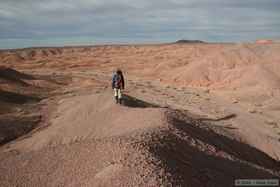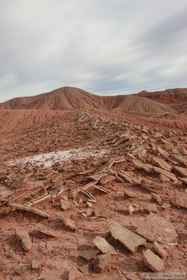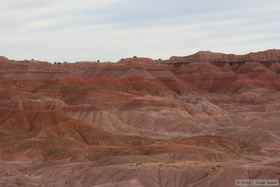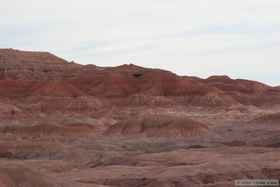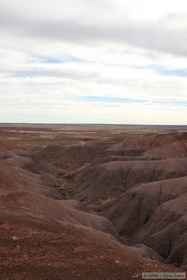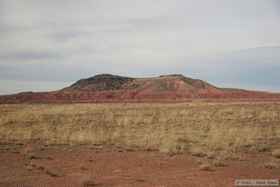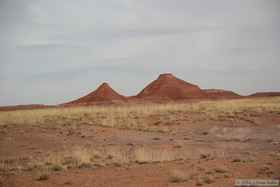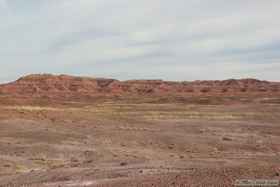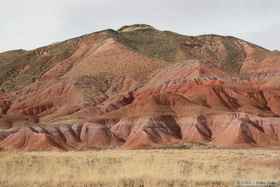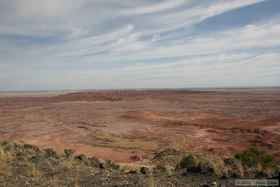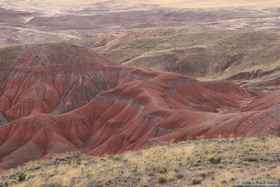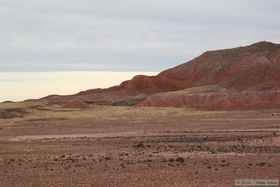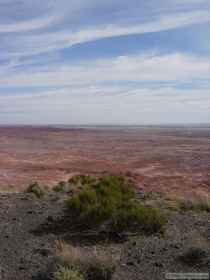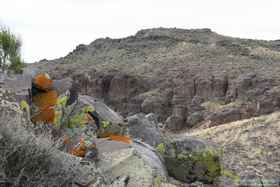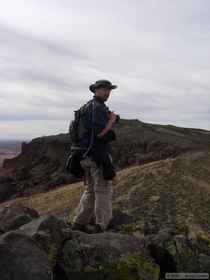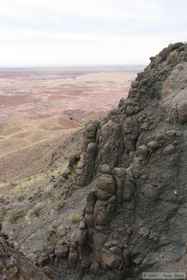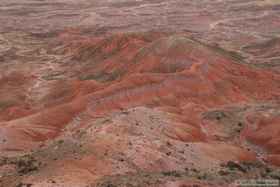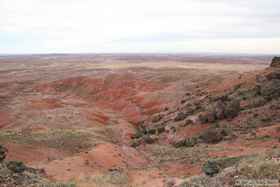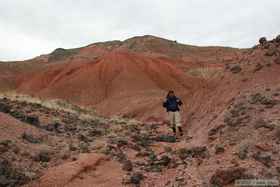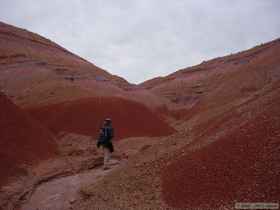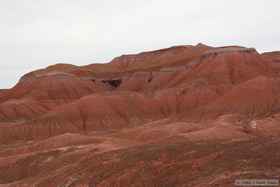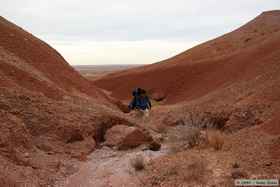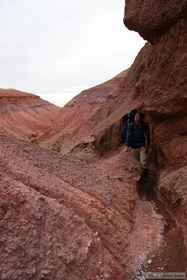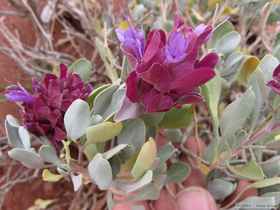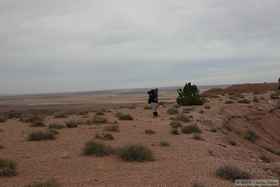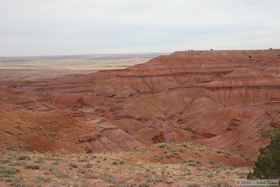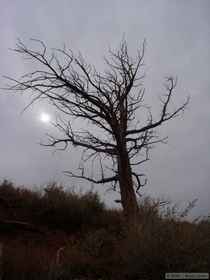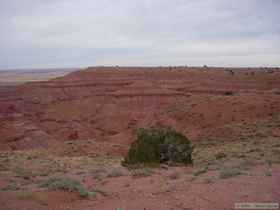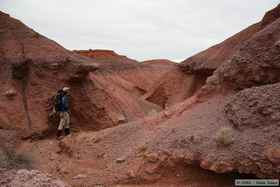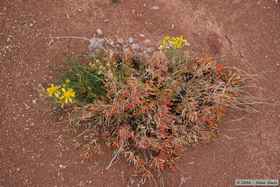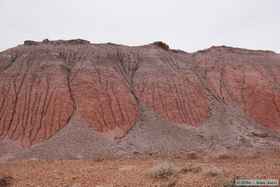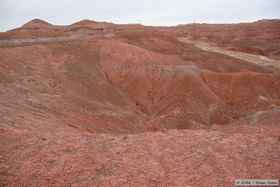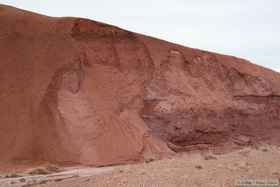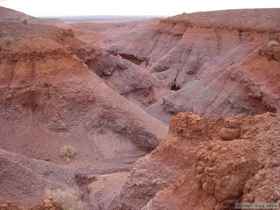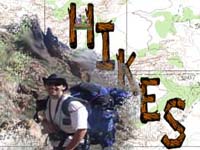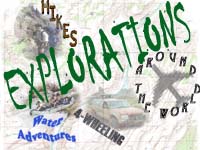Painted Desert-Petrified Forest Backpacking Trip, November 2006: Day 2
Added 1 January 2007, Revised 3 January 2018
Day 1 | Day 2 | Day 3

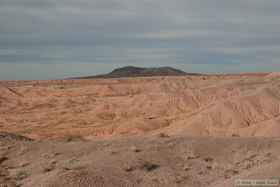
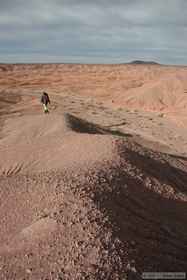 Saturday morning broke with cirrus clouds developing on the eastern and western horizons. When I checked the temperature on my GPS sometime after daybreak, it read 29 degrees Farenheit. By the time we started hiking towards Pilot Rock at around 8:45 a.m., the clouds made their rendezvous overhead and shaded the rest of the day. The wind continued to blow, making for frequent clothing layer changes as we heated up with hiking and cooled off when less active. One of our goals for the day was to investigate a ruin near the summit of Pilot Rock that is shown on the USGS 7.5 minute quadrangle map for the area. We set off overland on an unplanned course to cover the 4.5 straight-line miles between camp and Pilot Rock.
Saturday morning broke with cirrus clouds developing on the eastern and western horizons. When I checked the temperature on my GPS sometime after daybreak, it read 29 degrees Farenheit. By the time we started hiking towards Pilot Rock at around 8:45 a.m., the clouds made their rendezvous overhead and shaded the rest of the day. The wind continued to blow, making for frequent clothing layer changes as we heated up with hiking and cooled off when less active. One of our goals for the day was to investigate a ruin near the summit of Pilot Rock that is shown on the USGS 7.5 minute quadrangle map for the area. We set off overland on an unplanned course to cover the 4.5 straight-line miles between camp and Pilot Rock.
As we approached Pilot Rock, it was clear that we would have more route-finding issues to get to the top. After weighing our options as we approached closer and closer, we opted for an all out frontal assault on the mountain, essentially just powering our way straight up the eastern slope.
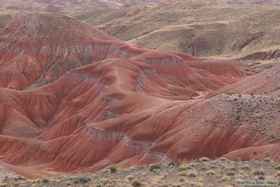
 When we arrived at the terrace below the peak, we wandered around looking for the ruin, but could find nothing even suggestive of human habitation. I started losing faith the the USGS at that point. They had steered me wrong twice in one weekend. Disappointed at not finding the ruin, we continued on to the top of Pilot Rock, which at 6,295 feet, is the highest point in Petrified Forest National Park. The peak affords an astounding view of the surrounding area. Even through the gray day, we could see the San Francisco Peaks, some 120 miles distant.
When we arrived at the terrace below the peak, we wandered around looking for the ruin, but could find nothing even suggestive of human habitation. I started losing faith the the USGS at that point. They had steered me wrong twice in one weekend. Disappointed at not finding the ruin, we continued on to the top of Pilot Rock, which at 6,295 feet, is the highest point in Petrified Forest National Park. The peak affords an astounding view of the surrounding area. Even through the gray day, we could see the San Francisco Peaks, some 120 miles distant.
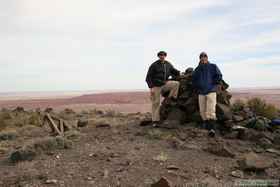
 The November wind was biting at the summit, but we braved it long enough to eat some lunch before wandering around the peak a bit. On our way down, I made one more attempt at finding the ruins, but once again had no luck. On the way down Pilot Rock, I came to the conclusion that Steve will go down any slope, without regard for the sanity of others. I followed him anyway, vowing all the way that it would be the last time.
The November wind was biting at the summit, but we braved it long enough to eat some lunch before wandering around the peak a bit. On our way down, I made one more attempt at finding the ruins, but once again had no luck. On the way down Pilot Rock, I came to the conclusion that Steve will go down any slope, without regard for the sanity of others. I followed him anyway, vowing all the way that it would be the last time.
 Once down off the mountain, we decided to try to find a route up the western slope of Chinle Mesa. We were more than once fooled by the topography, thinking we were someplace we weren't. At one point, we thought we were starting up the slope of Chinle Mesa, only to find that we were on a set of hills at the base of the mesa. When climbing down that low set of hills, I broke the vow I had made only a short while before, and found myself following Steve down a steep erosion rill.
Once down off the mountain, we decided to try to find a route up the western slope of Chinle Mesa. We were more than once fooled by the topography, thinking we were someplace we weren't. At one point, we thought we were starting up the slope of Chinle Mesa, only to find that we were on a set of hills at the base of the mesa. When climbing down that low set of hills, I broke the vow I had made only a short while before, and found myself following Steve down a steep erosion rill.
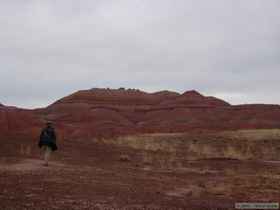 Once again, Chinle Mesa proved to be a more difficult challenge than Pilot Rock, despite its lower elevation. We eventually found a canyon that looked large enough that it might take us to the top. The canyon quickly closed in around us, then turned wet from a spring up-canyon. The clay made the narrow canyon bottom mucky, and didn't bode well for the ease of our climb, but we soon reached the source of the water and climbed above it to dry ground.
Once again, Chinle Mesa proved to be a more difficult challenge than Pilot Rock, despite its lower elevation. We eventually found a canyon that looked large enough that it might take us to the top. The canyon quickly closed in around us, then turned wet from a spring up-canyon. The clay made the narrow canyon bottom mucky, and didn't bode well for the ease of our climb, but we soon reached the source of the water and climbed above it to dry ground.
We managed to find a way to the top of the mesa, but found it more difficult than expected to travel on top. We found ourselves always trying to decide whether to snake around to stay on top, or travel in a straight line forcing us to climb and descend a lot.
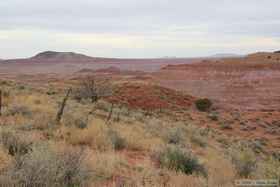
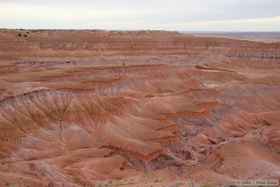 In the face of slow travel and a waning afternoon, we soon opted to dive down the southern face of the mesa then skirt around the base back to camp.
In the face of slow travel and a waning afternoon, we soon opted to dive down the southern face of the mesa then skirt around the base back to camp.  While route-finding down we encountered some interesting geological features, including a nearly perfect white X made by some unknown geologic process on a ridgeline. My first serious thought was that it was some sort of survey mark, but I traced the white markings out quite some distance and was amazed to discover them not man-made.
While route-finding down we encountered some interesting geological features, including a nearly perfect white X made by some unknown geologic process on a ridgeline. My first serious thought was that it was some sort of survey mark, but I traced the white markings out quite some distance and was amazed to discover them not man-made.
Once down off the mesa we followed our noses further south than we really needed to go, which turned out to be somewhat fortuitous. 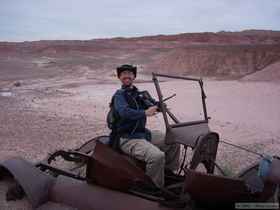
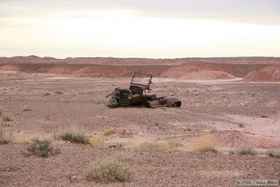 As we wandered down a wash Steve looked over and said "Look at that car over there." What I heard, was "Look at that wash over there." My brain couldn't register the word "car" under those circumstances. I looked over, and off in the distance was indeed a beautiful wash. I said, "yeah, isn't it nice?" Steve repeated his statement, which my brain paid more attention to the second time around.
As we wandered down a wash Steve looked over and said "Look at that car over there." What I heard, was "Look at that wash over there." My brain couldn't register the word "car" under those circumstances. I looked over, and off in the distance was indeed a beautiful wash. I said, "yeah, isn't it nice?" Steve repeated his statement, which my brain paid more attention to the second time around. 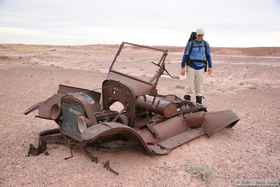 I focused on the foreground and there it was, an old Model T Ford in desperate need of a mechanic and body work sitting out in the middle of the Painted Desert. We tried to drive it back to camp, but it just wouldn't start. I have no idea why.
I focused on the foreground and there it was, an old Model T Ford in desperate need of a mechanic and body work sitting out in the middle of the Painted Desert. We tried to drive it back to camp, but it just wouldn't start. I have no idea why.
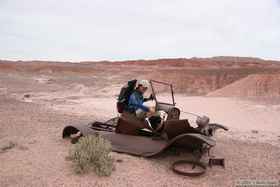
 When we let the Park Service know we had made it out alive at the end of the trip, I asked the ranger about the car. She said the car is a mystery, but they believe it may be the broken down wreck of a bootlegger. One of the rangers found the identification number from the engine block and sent it to the Henry Ford Museum back east, who is apparently researching it to try to determine the history of the car, and maybe who it belonged to.
When we let the Park Service know we had made it out alive at the end of the trip, I asked the ranger about the car. She said the car is a mystery, but they believe it may be the broken down wreck of a bootlegger. One of the rangers found the identification number from the engine block and sent it to the Henry Ford Museum back east, who is apparently researching it to try to determine the history of the car, and maybe who it belonged to.
(NOTE: In 2009, I was contacted by Aaron Minyard, who told me that he believes this Model T may have belonged to his great grandfather, who was indeed a bootlegger! Here's what Aaron told me:
My great Grandfather Beasley was a moonshine runner in Northeastern Arizona. He told my Father and Uncles about those days and how he would avoid the revenue agents. One of his tricks included keeping a Model T out in the desert at the end of the fuel range for the agent’s vehicle. He would drive towards the Model T with the agents chasing him, ditch the Model T he was in as it was running out of fuel and hop into the stored one. The agents would then run out of gas in the middle of the desert and he would head east towards Chambers. No one ever heard if the agents made it out.)
(NOTE 2: In 2017 I was contacted by Fred Fagergren, who told me another story about two Model T Fords in Petrified Forest, apparently a little west of the one we found. Here's what he had to say:
Anyway, I was told that Henry Ford wanted to show the endurance or usability of his vehicles and so three were sent out west to cross northern Arizona and continue to California. It story went that when the three vehicles were crossing the Painted Desert, two of the three got terribly stuck and the guys were not able to get them out. One continued to struggle on to Holbrook and the crew decided against trying to get the other two out. The story as I recall it now was that the two cars were still there. The rear end of one had slowly shifted down into the sand and was slowly be covered. The other one, we were told was more level with the axles stuck solid. I am not sure if we might be talking about the same general location where you found the car you photographed. The location of the two in this story was supposed to be more to the west from where you began your hike.)
By the time we got back to camp, we had a little bit of daylight left, but spent the waning afternoon near camp. It seemed it would be another cold night, and we'd expended a lot of energy over the course of the day, so we ate dinner a little early. Shortly after dark, the wind died down, which made for a relatively pleasant evening. It was after 9:30 before we retired to our tents. In the middle of the night, the wind picked up again, then turned into a frenzied banshee that severely compressed my tent despite the tied downs. Then I heard the splatter of rain hit the tent. My brain started whirring. I saw the headline: "Floodplain Management Official Swept Away by Flood in Tent: camped in wash." I knew the storm wouldn't produce much rain, or produce it quickly enough to generate flow, let alone a flash flood, but still the headline nagged me. I lay there on my back . . . whirring. Worrying. I wanted to move my tent onto the more rocky bank alongside the wash, but didn't want to over-react.
I heard Steve scrambling. I called out to him to see if he needed help, to which I got a "Well . . . maybe . . ." in reply. I sprang out of my sleeping bag and into some appropriate clothes to go help, glad to have something to do, and survey the sky for an answer to my nagging questions. Steve's tent stakes weren't holding in the sandy wash, and his tent was failing. I helped him stake it back down and get everything under cover in the light mist. After getting Steve's house back in order, I wandered down the wash to take care of nature's call and look west to assess the storm. It looked bad only in the sense that I was camped in a wash. I didn't truly expect it to do much, but I was awake, I was up and about, and I knew I wouldn't sleep a wink until my tent was on higher ground.
I talked with Steve and we agreed to work together to move our tents. We moved his first, and thankfully found firmer ground for his stakes, making his setup stronger, then moved mine. It wasn't as comfortable, but it was definitely safer, and the move ended up being a pretty quick and easy affair. And at least, finally, I could sleep with myself. It is a small irony that in the desert, washes are often the best - and sometimes only - places to camp, leaving one to risk having each step up canyon undone with a mighty whoosh.
The sky misted for a while longer then apparently stopped for good.
Day 1 | Day 2 | Day 3


 Saturday morning broke with cirrus clouds developing on the eastern and western horizons. When I checked the temperature on my GPS sometime after daybreak, it read 29 degrees Farenheit. By the time we started hiking towards Pilot Rock at around 8:45 a.m., the clouds made their rendezvous overhead and shaded the rest of the day. The wind continued to blow, making for frequent clothing layer changes as we heated up with hiking and cooled off when less active. One of our goals for the day was to investigate a ruin near the summit of Pilot Rock that is shown on the USGS 7.5 minute quadrangle map for the area. We set off overland on an unplanned course to cover the 4.5 straight-line miles between camp and Pilot Rock.
Saturday morning broke with cirrus clouds developing on the eastern and western horizons. When I checked the temperature on my GPS sometime after daybreak, it read 29 degrees Farenheit. By the time we started hiking towards Pilot Rock at around 8:45 a.m., the clouds made their rendezvous overhead and shaded the rest of the day. The wind continued to blow, making for frequent clothing layer changes as we heated up with hiking and cooled off when less active. One of our goals for the day was to investigate a ruin near the summit of Pilot Rock that is shown on the USGS 7.5 minute quadrangle map for the area. We set off overland on an unplanned course to cover the 4.5 straight-line miles between camp and Pilot Rock.
